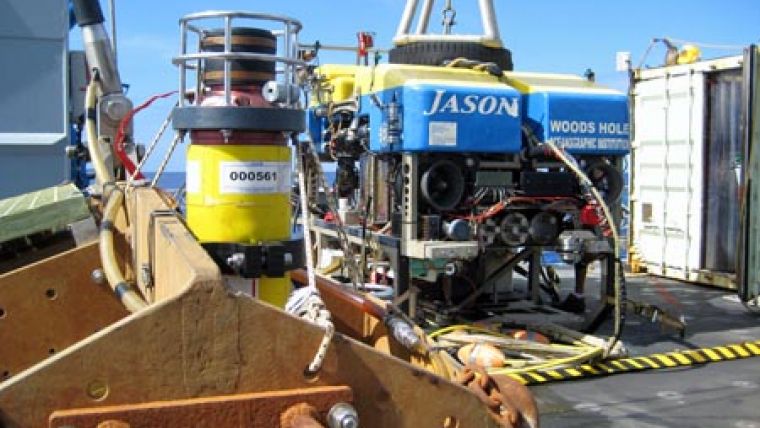Upgraded ROV Jason: Bigger and Better
A USD2.4 million upgrade funded by the National Science Foundation (NSF) has made the remotely operated vehicle (ROV) Jason, operated by Woods Hole Oceanography Institute (USA), more capable than ever. This year-long project, conducted by engineers at WHOI where the vehicle was also designed and built, has increased the vehicle payload and range of activities and streamlined the vehicle operation.
This is Jason’s first upgrade of this magnitude since its second-generation launch in 2002. The original Jason was launched in 1988. The ROV is operated by WHOI for the nation’s ocean scientists as part of the National Deep Submergence Facility (NDSF).
Higher Solo Lifting Capability
This upgrade enabled the researchers to increase the system’s lift capability from 400 pounds to 2-tons of scientific samples and instruments from the seafloor, and to eliminate its companion vehicle, Medea, for these operations.
Until this latest upgrade, Jason has been operated as a two-body system in concert with Medea, a smaller ROV that buffered Jason from the movement of the surface ship while providing lighting for its seafloor activities. Now, Jason can be de-coupled from Medea and operated as a single-body system, streamlining its launch and recovery and making the vehicle more versatile.
During a Jason mission, the ROV pilot, navigator and engineer operate the vehicle from a control van on the ship’s deck while Jason sends HD video in real time from the seafloor through its cable tether. Scientists in the control van observe and direct biological and geological sampling to ensure their scientific mission is accomplished.
A key reason behind the upgrade was to enable Jason to perform maintenance to seafloor infrastructure related to the NSF-funded Ocean Observatories Initiative and Ocean Networks Canada’s cabled observatories efficiently and with reduced need for deck space.
Instrument Lift Capability
The upgrade has other added benefits. The heavy lift capability will be used at seafloor sites where several-hundred-meters-long sensor strings are routinely deployed into and recovered from seafloor bore holes. It also will deploy and recover trawl resistant instrument packages. The Active Heave Compensated (AHC) winch and cable direct to Jason makes these operations less challenging and much faster.
Medea will still be used for scientific missions requiring depths greater than 4,500 metres, and on vessels equipped with cable strong enough to eliminate the need to install the new larger winch and cable system.
While the upgrade was specifically intended to increase Jason’s ability to deploy and recover scientific packages, the upgrade was an opportunity for engineers to redesign numerous systems to increase general scientific capabilities and to improve maintenance capabilities, which will result in less downtime.
The core components of the upgrade include:
- Bigger and stronger cable tether with break strength (BS) of 70,000lb. compared to the traditional cable tether with a BS of 42,000lb.
- A modified Active Heave Compensated winch to accommodate the new cable
- A Launch and Recovery System (LARS) to accommodate the increased payload rated to 15,000lb.
- A new vehicle frame capable of withstanding the increased loads
- A new swappable heavy lift tool skid that will be used for these lift operations
- New science tool skid with increased space and payload for scientific equipment
- Additional flotation to accommodate the increase in weight of the new frame.
The engineering effort began in April 2015, and culminated in complete overhaul, stripping the ROV down to its base, replacing the vehicle frame and improving system functions, which required three months.
Undersea Volcano Eruption
Since its original launch in 1988, ROV Jason has spent countless hours exploring the Earth’s oceans, taking samples and imaging the sea floor. Perhaps nothing was quite as dramatic as the 2009 observation of the West Mata volcano erupting at 1,100 metres’ depth in the Pacific. Through its fiber optic tether, Jason was able to transmit HD video of the explosive erupting volcano and its molten lava in real-time to stunned scientists and crew onboard the ship.
With significant enhancements to its design and capabilities complete, Jason will expand its range of operations to meet the changing needs of the ocean science community, which increasingly involves seafloor-based ocean observing infrastructure. Jason begins its first post-upgrade science mission in June 2016 aboard the SIKULIAQ, a ship owned by NSF and operated by the Univ. of Alaska, and has a full science schedule into 2017.

Value staying current with hydrography?
Stay on the map with our expertly curated newsletters.
We provide educational insights, industry updates, and inspiring stories from the world of hydrography to help you learn, grow, and navigate your field with confidence. Don't miss out - subscribe today and ensure you're always informed, educated, and inspired by the latest in hydrographic technology and research.
Choose your newsletter(s)
























